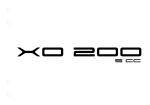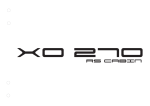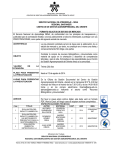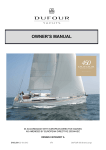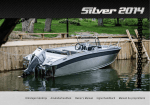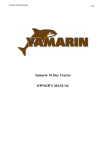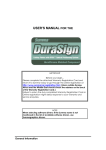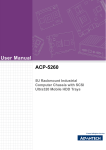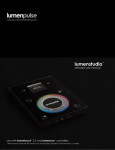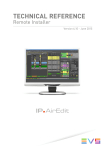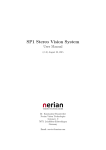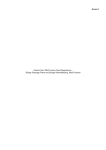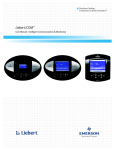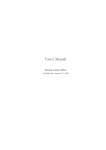Download manual
Transcript
1 w w w. x o b o at s . f i 2 XO BOATS competent and fit crew in a well-maintained boat. This User Manual is not a detailed maintenance or troubleshooting guide. If a problem occurs, please contact your XO dealer. If a repair is required, use only PREFACE the companies recommended by your XO dealer. Congratulations on your new Finnish XO boat! We want to thank you KEEP THIS MANUAL IN A SAFE PLACE AND HAND IT OVER TO for choosing XO and we hope you enjoy the time you spend aboard. THE NEXT OWNER IF YOU SELL THIS BOAT. The purpose of this manual is to help you operate your boat with safety and pleasure. The manual contains the details of the boat and the associated or installed equipment and systems, as well as information on its operation and maintenance. Please read the manual carefully and familiarise yourself with the boat before using it. Naturally, you cannot learn the skills of seamanship and safe boating by reading a User Manual. If this XO is your first boat, or if you are changing to a type of boat you are not familiar with, for your own comfort and safety please ensure that you obtain handling and operating experience before assuming command of your boat. Your dealer, boating clubs and national sailing and yacht federations will be pleased to advise you of local boating schools and competent instructors. Make sure that your boat's design category is appropriate for the expected wind and wave conditions, and that you and your crew are capable of handling the boat in such conditions. The wind and wave conditions specified for design category C may include gales and high winds, with risk of exceptional waves and gusts. Such conditions are dangerous and can be sufficiently handled only by a 3 4 Contents 5.10 Safe operation – other recommendations and information24 1. BEFORE DEPARTURE 9 2 General 11 3 Warranty 12 4 Before using your boat 12 5.10.2 Securing loose equipment 4.1 Registration 12 5.10.3 Respect for the environment 24 4.2 Insurance 12 5.10.4 Anchoring, mooring and towing 26 5.10.1 Protection from falling overboard and means of reboarding 24 24 4.3 Training 12 5.10.5 Trailering 5 Boat characteristics and operation 13 5.10.6 Navigation 28 13 6 Service, repairs and winter storage 29 5.3 Maximum recommended number of persons 13 7 Optional equipment 30 5.4 Load capacity 14 7.1 General 30 5.5 Engine and propeller 14 7.2. Installing optional equipment 30 5.6 Flooding and stability 14 5.1 General 7.2.1 Heater 7.2.2 Radio/CD player 28 30 30 5.6.1 Openings in the hull and deck 14 5.6.2 Bilge pumps and drainage 14 APPENDIX 1 TECHNICAL SPECIFICATIONS 32 5.6.3 Stability, buoyancy and flotation 16 APPENDIX 2 XO 220 S – GENERAL LAYOUT 34 16 Appendix 3 General requirements 35 16 Appendix 4 WIRING DIAGRAM 36 5.7 Minimising risk of fire and explosion 5.7.1 Engines and fuel systems 5.7.2 Fire-fighting and prevention 17 5.8 Electrical system 18 5.9 Handling characteristics 22 5.9.1 Driving at high speed 22 5.9.2 Dead man's switch 22 5.9.3 Visibility from the steering position 23 5 6 BOAT MODEL: XO 220 S Open Craft Identification Number – CIN: Engine make and model: Engine serial number: 1st owner 4th owner First name: First name: Last name: Last name: Place of domicile: Place of domicile: Year of purchase: Year of purchase: 2nd owner 5th owner First name: First name: Last name: Last name: Place of domicile: Place of domicile: Year of purchase: Year of purchase: 3rd owner 6th owner First name: First name: Last name: Last name: Place of domicile: Place of domicile: Year of purchase: Year of purchase: 7 8 1 BEFORE DEPARTURE Engine and equipment Check the operation and condition of steering, electrical devices and battery, and perform all daily inspection procedures specified Read this User Manual carefully. in the engine manual. Check the boat's seaworthiness in general: Before each departure, check at least the following: check the boat for fuel and water leaks, make sure that the necessary safety equipment is on board, etc. Check that the bilge water Weather and weather forecast level is at the minimum. Take the wind, waves and visibility into account. Is your boat's design category, size and equipment, as well as the skills of the helmsman Ventilation and crew adequate for the waters you are about to boat? Make sure that the fuel tank compartment is properly ventilated to minimise the risk of fire. Load capacity Do not overload the boat and always distribute the load properly. Securing of equipment To avoid diminishing your boat's stability, do not place heavy items Make sure that all items on board are secured so that they remain too high up. in place in rough seas and high wind. Passengers Nautical charts Make sure that a life jacket is available for each person on board. If you are not fully familiar with the planned route, make sure that Before departure, agree on the tasks to be performed by each per- you have nautical charts that cover a large enough area. son during the outing. Departure procedures Fuel Agree with the crew on whose task it is to detach each line, etc. Make sure that there is enough fuel on board, including a sufficient Make sure that the mooring lines or any other lines do not get reserve in case of bad weather, for example. You should have at least caught in the propeller during manoeuvring. a 20% reserve to allow for the unexpected. Refer to the separate engine manual for additional instructions on the engine. 9 10 2 General The units used in this manual are in accordance with the SI system. In some cases, however, other units are added in brackets. An exception to the above is the wind force, which is expressed in the The purpose of this User Manual is to help you familiarise yourself Beaufort scale in the Recreational Craft Directive (RCD). with the characteristics of your new boat. Separate manuals for the equipment installed on the boat are attached and also referred to in a number of sections of this manual. Naturally, you can complement this manual with manuals of any device installed later on. There is also space reserved for your own notes at the end of this manual. The warnings and precautions in this manual are defined as follows: DANGER! Indicates a serious hazard that will most likely result in death or permanent injury unless appropriate precautionary measures are taken. WARNING! Indicates a hazard that could result in injury or death unless appropriate precautionary measures are taken. NOTE! Indicates a reminder of safe practice or directs attention to a dangerous practice that could result in injury or damage to the boat or its components. 11 3 Warranty This boat and the equipment installed by the boatbuilder are 4 Before using your boat 4.1 Registration covered by a warranty as specified in detail below. The engine, trim tabs, compass, any navigation devices and other ret- In many countries, even a small motor boat must be registered. Con- rofitted devices are subject to any warranty of their respec- tact the local authorities for the registration requirements in your tive manufacturers. Separate warranty cards for these devi- country. To drive a registered boat, one must usually meet the requi- ces and appropriate supplier information are included as an rements for minimum age and also possibly have a separate boat attachment. For other warranty issues, please contact your driver's licence. XO dealer indicated on the front cover. 4.2 Insurance Boat insurance can cover for damage when the boat is in use, transported or stored. Remember to check the insurance coverage separately for lifting operations. Insurance also has an indirect effect on safety at sea: in the event of a serious accident, you can focus fully on the essential – saving lives above all else. More detailed information on various insurance alternatives is available from insurance companies. 4.3 Training There is a lot of boating literature available, and a great deal of beneficial and practical information can also be gained from boating clubs and by attending navigation courses. These can provide a sound basis for your skills, but sureness in handling, navigating, mooring and anchoring the boat is only acquired through practice. 12 5 Boat characteristics and operation 5.1 General Main dimensions and capacity: The length, beam, draught, total weight, etc., and fuel tank capacity of the boat are described in Appendix 1 ‘Technical specifications’. This User Manual is not intended to be a comprehensive maintenance guide or repair manual. Instead, the pur- Builder's plate: pose is to help you familiarise yourself with the characteris- Part of the above information is indicated on the builder's plate tics of your new boat and show you how to use it properly. attached to the boat in the vicinity of the helm station. More detailed information is given in the appropriate sections of this manual. 5.2 Principal boat data Please note that, for example, the maximum load capacity indicated XO 220 S: on the builder's plate does not include fuel, but the fuel is included Boat type: XO 220 S in the maximum recommended load specified by the manufacturer. Design category: C (inshore) Maximum recommended load: 690 kg 5.3 Maximum recommended number of persons See also Section 5.4 ‘Load capacity’ The maximum recommended number of persons on this boat is 6. Design category C can be defined as follows: Category C: The boat is designed for conditions in which the wind force does not exceed 6 on the Beaufort scale (about 14 m/s) The designated seating arrangement is shown in Figure 1. WARNING! and waves are consistent with the wind force (the signifi- Do not exceed the maximum recommended number of persons cant wave height must not exceed 2 m, with occasional waves on board. Irrespective of the number of persons on board, the of 4 m maximum). Such conditions can occur in open water on total weight of the persons and equipment must never exceed lakes, estuaries, and in coastal waters in moderate weather. the maximum recommended load (see Section 5.4 ‘Load capa- NOTE! The significant wave height is the average height of the highest city’). Always use the seats in the boat. If your boat is not equipped with seats for 6 people, the passengers must sit on the sole in the positions indicated in the figures. third of the waves. This roughly corresponds to an experienced observer's estimate of the wave height. Waves of double this height may occasionally be experienced. 13 5.4 Load capacity 5.6 Flooding and stability The maximum recommended load for XO 220 S is 690 kg. 5.6.1 Openings in the hull and deck An adult's weight is taken to be 75 kg and a child's 37.5 kg. The maxi- The XO boats are not equipped with plugs for draining the deck, but mum recommended total weight of the persons on board is 450 kg. the drain pipes are fitted with shut-off valves. See the general layout In addition to the maximum recommended weight of persons men- of XO 220 S (Appendix 2). XO 220 S has two drain holes located tioned above, the boat can be loaded with the following: 30 kg of on the deck from where the rainwater is drained. In addition to the basic equipment and 150 kg of fuel in the fixed fuel tank. The recom- rainwater, the drain holes are intended to drain water ending up on mended load includes only the weight components specified above. the deck through splashing or from breaking waves. The drain holes WARNING! must be open at all times. Clean out the holes regularly by removing any accumulated debris to prevent clogging. The boat is also Never exceed the maximum recommended load when loading your equipped with a screw-in transom drain plug at the bottom corner boat. Always load up the boat carefully and distribute the load pro- of the transom that can be used for draining the boat when it is laid perly so that the designed waterline is maintained (approximately up ashore or on a trailer. on an even keel). Avoid placing heavy weight in a high position. 5.5 Engine and propeller NOTE! The self-draining deck system is intended to drain the majority of rainwater and water ending up on the deck through splashing or The maximum rated outboard engine power for XO 220 S is 148 from breaking waves. A portion of the rainwater and water con- kW. Normally, outboard engines are designed to be installed so densing in the bilge may end up in the bilge. DO NOT LEAVE THE that the cavitation plate above the engine propeller is level with BOAT UNATTENDED IN WATER FOR LONG PERIODS. PAY ATTEN- the boat's keel line. Always follow the engine manufacturer's TION TO THE FLOATING POSITION OF THE BOAT AND DRAIN THE instructions when installing the engine and choosing the propeller. BILGE WHEN NECESSARY. Leaving the boat unattended in water In addition, read the engine manual carefully. When starting the for a long period may lead to damage. engine, check that the cooling water flows properly and make sure that the gear is in the neutral position. If the engine starts 5.6.2 Bilge pumps and drainage when the gear is not in neutral, contact your nearest service The location of draining devices is shown in Figure 2. The bilge centre. pumps are positioned as close to the bottom plate as is practically possible. Despite this, it is completely normal that a small amount 14 Loading and seating (Figure 1) Seat Alternative seat Bilge pumps and drainage (Figure 2) Electric bilge pump Manual bilge pump Bilge pump intake and intake hose Bilge pump discharge hose 15 of water remains in the bilge so that it cannot be discharged by the 5.6.3 Stability, buoyancy and flotation bilge pump. XO 220 S is equipped with an automatic, electric bilge The stability of your XO boat is excellent due to its hull design and pump. It discharges water accumulated in the bilge when the level weight distribution. However, remember that high breaking waves sensor detects water. The automatic pump is always in the standby always represent a serious danger to stability. Also note that the mode irrespective of the main switch position, provided that the stability of your boat will be compromised if any weight is placed in battery is connected. The bilge pump starts when the sensor has a high position. All changes in the positioning of different weights been fully submerged for 5 seconds, and stops once the sensor in the boat can have a significant impact on the stability, trim and does not detect water. The pump can also be activated manually performance of your boat. If you are planning such changes, please with the spring-loaded switch located on the switch panel. Regu- contact the boat manufacturer. The amount of bilge water should be larly check the electric bilge pump inlet and remove any debris. You kept at a minimum because freely moving water in the boat always can access the pump through the service hatch in the engine well. impairs the boat's stability. Also note that stability can be diminis- WARNING! The bilge pump system is not designed to deal with a leak hed when towing or being towed. 5.7 Minimising risk of fire and explosion resulting from running aground or other damage. NOTE! 5.7.1 Engines and fuel systems The XO 220 S is equipped with a fixed fuel tank, which is loca- Check the amount of bilge water by emptying the bilge ted in the centre section of the bilge area. Shut down the engine manually with the spring-loaded switch located on the switch before refuelling. Do not smoke or use a naked flame. Do not use panel every time before use. any electrical devices. The fuel fillers are located on both sides of We recommend that the user has at least the boat, above the deck drain holes. Lift the spare fuel tank out of one bucket or bailer on board. the boat for refuelling to prevent fuel from getting in the bilge in NOTE! case of overfill. When you refuel in a fuel station, do not use a plastic funnel that will prevent discharge of static electricity between Regularly check the operation of the bilge pump. If you notice that the pump nozzle and fill fitting. After filling the tank (for the tank the bilge pump does not operate properly, remove any debris from capacity, see Appendix 1 ‘Technical specifications’), check that no the pump inlet and contact your XO dealer if necessary. fuel has leaked into the bilge or engine compartment, and immediately remove any spilled fuel. Do not keep spare fuel canisters in an unventilated space or have them loose in the boat, and do not 16 keep any equipment containing fuel in a place that is not specifically designed for it. At least once a year, check the fuel hoses for wear. SPECIAL WARNINGS Never 5.7.2 Fire-fighting and prevention Whenever the XO 220 S is used, it must be equipped with fire extinguishers with a minimum fire rating of 8A 68B. The minimum fire rating for an individual fire extinguisher is 5A 34B. A hand-held fire extinguisher is located in the front section of the port seat con- • obstruct access to the safety equipment, fire extinguisher, fuel valves or main switch • block any ventilation openings as they are designed to vent out any fuel vapour. Also, never sole, on the left-hand side of the storage compartment, as shown in • make changes to your boat's electrical or fuel system, or allow Figure 3. You must have the hand-held fire extinguishers inspected an unqualified person to make changes to any system on the regularly at specified intervals, depending on the legislation in your country. Contact the local fire authorities for the inspection policy boat • fill the fuel tank or handle fuel when the engine is running in your country. If you are unsure of the inspection policy in your country, have your hand-held fire extinguishers inspected once a year. The manufacturing date of a hand-held fire extinguisher is indi- Location of fire extinguishers cated on a label attached to the fire extinguisher. Fire extinguishers (Figure 3) that are more than ten years old will not be approved unless the pressure vessel is pressure tested again. When replacing a handheld fire extinguisher, it must be replaced with an extinguisher with an extinguishing capacity that is at least the same as the old one. The owner/user of the boat should make sure that there is at least one easily accessible fire bucket with a line attached to it. Make sure that all fire-fighting equipment is easily accessible when the boat is loaded. Inform all crew members of the location and operation of the fire-fighting equipment. Keep the bilge free of fuel and check the fuel system for leaks regularly. Fuel smell is a sure sign of a fuel leak. If your boat is equipped with a heater, refer to the heater manufacturer's instructions for its safety instructions. Fire extinguisher 17 • smoke or use a naked flame when handling fuel are equipped with automatic fuses. If such a fuse is tripped as a • keep fuel in a space that is not designed for such purpose. If result of overload, you can easily reset it by pushing down the fuse the boat is not equipped with a heater, a spare fuel tank can be button that has popped up. The electrical system has two additio- stored in place of the heater's tank. nal circuits, ‘Extra 1’ (10 A) and ‘Extra 2’ (10 A) (wiring diagram posi- • leave the boat unattended when a cooker or heater is in use. tions F13-F14 and F17-F19). These circuits are protected with fuses and are designed for connecting retrofitted optional equipment. The 5.8 Electrical system wires for these circuits can be found in the switch panel. Do not replace the fuses with fuses that have higher current ratings, and do The boat's wiring diagram is shown in Appendix 3. The main switch not add components to the electrical system so that the circuit's is located on the starboard side, behind the helm station. However, nominal amperage rating is exceeded. the automatic bilge pump is always operational when the battery is connected. When the circuit is closed, the various devices can be Zinc anodes are installed on the transom. Replace the anodes when operated with the switch panel at the helm station. they are over 50% of their original size. The navigation lights are switched on with the running light switch WARNING! (see Figure 5). Remember to install the removable mast light in posi- Never use the hull for earthing. Both the negative and positive tion. Windscreen wipers on either side of the boat are operated with sides of all electrical installations must be insulated from the hull. appropriate switches. To check the amount of bilge water, activate the bilge pump with its switch (see Figure 5). If you cannot hear the sound of water flowing beside the boat at the stern, the automatic system has drained the water properly. The electrical system is pre-fitted for adding various optional equipment, and is fully fitted for adding a radio/CD player and two speakers. The boat is also partially fitted for adding a fuel-burning heater. The layout of controls and electrical equipment is shown in Figures 4, 5 and 6. The fuses for electrical circuits are located in a separate fuse panel inside the helm console (see Figure 4). The XO boats 18 Electrical equipment (Figure 4) Location of electrical equipment: Battery compartment Main switch Bilge pump Mast light, white, 360° Mast light white, 360° (w/ targa arch) Navigation lights, red and green Switch panel Power outlet, 12 V, max. 10 A Fuse panel (see Figure 6) Windscreen wiper 19 CONTROLS (Figure 5) Switch panel: Bilge pump switch Horn Windscreen wiper, port Windscreen wiper, starboard Navigation light switch AUX On the next page (Figure 6): Trim tab control, port Trim tab control, starboard 20 FUSE PANEL (Figure 6) F1 Navigation lights F2 Trim tabs F3Horn F4 12 V power outlet F5Radio F6 Automatic fire extinguisher F7 Windscreen wiper, starboard F8 Windscreen wiper, port F9Aux F10 Bilge pump F11Extra F12 Chart plotter F13Spare F13 21 NOTE! down’ position • When retrofitting optional equipment on the boat, use the ‘Extra • Once the boat is on plane and if the waves are small, lift the bow 1’ or ‘Extra 2’ circuits. Connect the device to both the power supply until the boat starts to porpoise, the propeller loses grip or the and negative wire. Never earth the device to the hull. engine reaches the upper limit of its normal adjustment range. Then • If you leave the boat for a longer period, turn the main switch to lower the bow from this position slightly so that the ride feels stable. the off position. Disconnect the battery from the electrical system You can use the speed log to optimise the trim. before carrying out electrical installations. When you disconnect • When running into a head sea, lower the bow to make the run or connect the batteries, be careful not to simultaneously touch smoother. In a following sea and a very high head sea, lift the bow both battery posts or aluminium parts of the boat with a metal slightly to prevent it from diving in. spanner or other metal tool. • Do not drive the boat at high speed when the trim is negative, • Use only the engine or a battery charger to charge the batte- i.e. when the bow is low, because the boat can heel and become ries. Charging with too high a current presents a risk of battery unstable to steer. To adjust the trim, also refer to the engine explosion. Make sure that the battery compartment is properly manufacturer's instructions. ventilated. Charging a battery generates hydrogen gas which can explode if the ventilation is not sufficient. WARNING! • Never turn the main switch to the off position when the eng- If you drive at high speed, adjust the trim carefully as it will radi- ine is running, because this can damage the engine. Do not make cally change the behaviour of the boat. Do not drive with the bow changes to your boat's electrical system or related diagrams. All too low because the boat can suddenly turn. Do not drive the boat changes and servicing must be carried out by a qualified techni- at high speed when the trim is negative (bow low). The boat can cian specialised in marine electrical systems. heel or become unstable in turns. 5.9 HANDLING CHARACTERISTICS WARNING! Handling is impaired at speeds exceeding 40 knots. Rapid turns 5.9.1 Driving at high speed can lead to loss of control. Slow down before sharp turns in either The maximum rated engine power is 148 kW (200 hp). direction. Avoid rapid movements while driving at high speed. Do Do not use the boat if it has an engine with a higher power rating not drive at full speed if traffic on the waterway is high or visibi- than that indicated on the builder's plate. Use the engine's electro- lity is restricted. hydraulic power trim feature as follows: • When you are rising the boat to plane, adjust the trim to the ‘bow 22 WARNING! stops if you stumble on board or fall overboard for some reason, par- Waves impair the boat's handling and can cause it to heel. Take ticularly if you are alone. However, remember to detach the lanyard this into account and reduce speed when waves become higher. from your wrist before docking or beaching operations to prevent Learn and obey the rules of navigation on waterways, and also familiarise yourself with the rules known as COLREGs (Internatio- the engine from stopping unintentionally. nal Regulations for Preventing Collisions at Sea) that you must fol- DANGER! low at all times. According to the rules, every vessel must maintain a A rotating propeller can be lethal for a swimmer or person who has proper look-out and obey the give-way provisions at all times. Navi- fallen overboard. Use the dead man's switch and shut down the gate carefully and use new or updated nautical charts. Always adjust engine when a swimmer or water skier climbs on board. your speed in relation to the prevailing conditions and environment. 5.9.3 Visibility from the steering position Pay attention to the following: Driving in beautiful and calm weather is easy once you ensure pro- • waves (also consult your passengers on their opinion of a com- per visibility which also complies with the rules of COLREG. Always fortable speed) ensure that visibility from the steering position is as good as pos- • your own wake (highest when rising to plane and lowest at displa- sible: cement speed, i.e. below 10 knots). Always observe no wake zones. • position the passengers so that they do not impair the helmsman's Slow down to reduce your wake to be courteous and also for the visibility safety of yourself and others in the area. • do not drive continuously at planing threshold speed at which high • visibility (islands, fog, rain, blinding sun) bow rise impairs visibility • knowledge of the route (time required for navigation) • adjust the engine power trim and possible trim tabs to set the boat • narrowness of the route (other traffic, noise and impact of wakes position so that the rising bow does not impair visibility on shore) • remember to keep a good lookout astern as well, especially on fair- • space required for stopping and taking evasive action. ways in case of approaching ships. Use appropriate navigation lights after dark and in limited visibility (fog, heavy rain). 5.9.2 DEAD MAN'S SWITCH Attach the lanyard of the dead man's switch to your person immediately after detaching the mooring lines. For more detailed instructions, refer to the engine manual. It is very important that the boat 23 5.10 Safe operation – other recommendations and Do your best to avoid the following: information • fuel or oil spills 5.10.1 Protection from falling overboard and means of reboar- • discharging detergents or solvents into the water ding • loud noise both out on the water and in harbours Your boat's working decks are indicated in Figure 6. Do not sit, stand • generating high wakes, especially in narrow passages and • disposing rubbish or waste into the water or on shore or stay on any other section of the boat when moving. Before you shallow waters. get underway, make sure that the aft rails are in the locked position. If someone falls overboard, the easiest way to reboard is via Observe the local environmental legislation and regulations. Fami- the bathing/rescue ladder on the stern. A person in the water can liarise yourself with the international regulations on the prevention also deploy the ladder. of marine pollution (MARPOL) and comply with these regulations as far as possible. 5.10.2 Securing loose equipment Secure all heavy equipment (for example, anchors) before getting underway. Pay attention to lightweight items as well because they can be easily taken away by wind. Keep all hatches closed when underway. 5.10.3 Respect for the environment Archipelagos and lakes are unique, and their conservation is a matter of honour for all boaters. 24 Working decks and bathing ladder (Figure 6) Bathing ladder Working decks 25 5.10.4 Anchoring, mooring and towing WARNING! Always moor your boat carefully, even in sheltered places, because Do not try to stop the boat by hand or place your hand or leg bet- conditions can change rapidly. The mooring lines should be equip- ween your boat and a dock, shore or another boat. Practice dock- ped with appropriate absorbers to dampen shocks. For the location ing and beaching in good conditions and remember to apply the of fastening points, see Figure 7. Do not use other boat components engine power in a gentle but determined manner. for fastening, towing or anchoring. Use sufficiently large fenders to protect the boat from chafing. The eye on the stem is only desig- When you moor your boat, bear in mind the wind-direction changes, ned for docking on a slipway or for fastening the boat to a trailer. It rise and fall of water level, wakes, etc. Additional instructions can be is not to be subjected to lateral forces present when, for example, provided by your insurance company, for example. If you tow anot- the boat is secured to a dock. The strength ratings for the fastening her boat or if your boat is being towed, always drive slowly and use points are also shown in Figure 7. a floating tow line that is sufficiently strong. Start towing carefully, avoid sudden jerks and do not overload the engine. Make sure that The owner/user of the boat is responsible for ensuring that the moo- the tow line cannot get caught in the propeller. If the boat you are ring, towing and anchoring lines, as well as the anchors and anchor towing is of the displacement hull type, never exceed its hull speed. chains are appropriate for the intended use of the boat, and that the If you tow a small dinghy, adjust the length of the tow line so that tensile strength of the lines and chains does not exceed 80% of that the dinghy rides downhill on your wake. However, you should pull the of the corresponding fastening points. However, wear and tear of the dinghy close to the transom in narrow passages and on high waves lines and knots weakening the lines must be taken into account. If to minimise wiggling. Carefully secure all equipment in the dinghy you tow the boat, note that the strength ratings for the front cleats in case it capsizes. Cover the dinghy if you tow it on waves in open differ from those of the aft cleats. If you are going to beach the boat water to prevent it from being filled by splashing water. If you tow at an excursion harbour or similar natural harbour, make sure that another boat or if your boat is being towed, attach the tow line to the depth of the water is sufficient and DROP YOUR ANCHOR AT A the fastening points shown in Figure 8. Attach the tow line so that SUFFICIENT DISTANCE FROM THE SHORE. A fair holding power is it can be detached under load. achieved if you pay out anchor rode so that its length is 4 to 5 times the depth of the water at the point where you dropped the anchor. The tensile strength of the lines or chains should normally not The grip is increased the more anchor rode you deploy. The anchor exceed the tensile strength of the fastening point in question. holding power is also significantly increased if the first 3 to 5 metres of the anchor rode is weighted line or chain. Always attach the tow line so that it can be detached under load. 26 NOTE! WARNING! • The tensile strength of the lines or chains should normally not The tow line is subject to high tension. If the line breaks, the loose exceed the strength of the fastening point in question. end could cause death due to high speed. Always use a line that is • Always attach the tow line so that it can be detached under load. sufficiently thick, and never stand in line with the tow line. • When towing another boat or being towed, always drive slowly. If the boat you are towing is of the displacement hull type, never The strength rating for the front cleat in towing and exceed its hull speed. anchoring is 22 kN. For mooring purposes, the forward force rating for the front cleats is 18.1 kN and for the aft cleats 15.4 kN. Towing and mooring (Figure 7) Fastening points (cleats) for towing, mooring and anchoring Eye for trailering 27 5.10.5 Trailering the hood completely if necessary. Moreover, make sure that the boat Before lifting your XO boat onto the trailer, make sure that the trai- door is properly closed before trailering. ler is suitable for your boat: there is a sufficient number of supports to distribute the weight properly without excessive point loads, and NOTE! the capacity and dimensions of the trailer are sufficient to carry the The trailer must be a little nose heavy. Make sure that the boat is boat and its engine, equipment, battery, boating accessories and securely fastened to the trailer, that it cannot move into any direc- fuel on board. Carefully familiarise yourself with the national road tion, and that the side supports provide an even support for the traffic regulations on towing a trailer and associated licence requi- weight of the boat. The hull of the boat can be damaged if the boat rements. Also check that the towing capacity of your vehicle is suf- swings against a single support during transport. ficient for the intended combination. Before loading the boat on the trailer, remove any unnecessary weight from the boat and drain the WARNING! bilge water. Adjust the side supports of the trailer so that the most A boat trailer that does not have sufficient capacity or weight of the boat rests on the keel supports and the side supports that is poorly maintained can become damaged and cause a only offer lateral support. Use only the eye on the stern to load the danger on the road. Make sure that the trailer capacity is suffi- boat on the trailer because the other fastening points are not strong cient to also carry the weight of the engine, fuel and equipment. enough to withstand the weight of the boat in loading operations. Fasten the boat securely to the trailer before trailering on the road. WARNING! Protect the boat by placing suitable padding between the tie-down Do not use a hood, canopy, tonneau cover or other similar top or straps and the boat if necessary. Refer to the engine manual for any cover on the boat during trailering. These hoods and covers can instructions on trailering. become detached at high speeds and damage the boat and cause a danger to traffic. In addition, pay attention to any equipment and accessories in the boat during trailering. Make sure you secure all loose items in the 5.10.6 Navigation boat. Do not use a hood, canopy, tonneau cover or other similar top You must always have a compass and an up-to-date nautical chart or cover on the boat during trailering. These hoods and covers can on board, even if you navigate using a chart plotter or other such become detached at high speeds and damage the boat and cause device. The GPS devices are intended to support navigation and they a danger to traffic. Moreover, a hood or other cover flapping in the should not be used as the primary navigation tool. The helmsman of wind during trailering can damage the boat surface. Keep the hood the boat must have at least basic navigation skills. in its dedicated storage compartment during trailering, or remove 28 6 Service, repairs and winter storage For information on your boat's maintenance, winter storage, service and repairs, please consult your local XO dealer. If you detect any major damage on the aluminium or surface finish, you should have it repaired by an authorised XO dealer. In case of a problem with the engine or a retrofitted equipment, please consult the appropriate supplier first. NOTE! Make sure that the cleaners, protectors and other surface treatment agents are suitable for aluminium and other surfaces you treat. Always follow the chemical manufacturer's instructions. 29 7 Optional equipment 7.1 General NOTE! 7.2. Installing optional equipment XO 220 S can be equipped with a range of optional electrical equipment for which the necessary circuits are already fitted and wires routed. Below is a description of the possible optional equipment If not carried out properly, many installation and modification ope- and the location of appropriate wiring. For more detailed installa- rations can damage the boat structure or create a safety hazard. tion and operating instructions, refer to the instructions supplied Please contact the manufacturer before you or somebody else by the equipment manufacturer. does any of the following: construct new earthing points or hatches, fasten or install new equipment on the boat, or mount other 7.2.1 Heater metal alloys to aluminium. The boat layout features a reservation for installing a diesel-burning NOTE! heater. The actual heater with the associated systems is to be installed inside the passenger console. For more information, refer If you or somebody else installs optional equipment on the boat, to the installation instructions supplied by the heater manufacturer use insulating washers made of non-conductive material and the heater installation instructions for the XO 220 S. under the surface that is in contact with the treated aluminium surface (i.e. under the mounting surface of the equipment or 7.2.2 Radio/CD player screw head). A wire harness for installing a car radio/CD player on the boat is available as an option. The head unit is to be installed on the port console under a sliding cover. The wire harness is equipped with an Euro connector, which contains the constant power supply by-passing the main switch for the radio memory function, the main power supply via the main switch, and the necessary wires for two speakers. The speaker wires are routed to each console, and the speakers are to be installed on the footwell wall. 30 31 APPENDIX 1 TECHNICAL SPECIFICATIONS The boat is marked with a running serial number known as the CIN (includes the engine, battery and basic equipment (Craft as per the hull length.)(Maximum engine weight: 280 kg) Identification Number). The CIN is marked on the hull, on the starbo- Weight, fully loaded: 2,000 kg ard side of the stern, on the outer surface of the transom beside the Weight on a trailer: 1,550 kg edge strip. You can record the CIN of your boat in the table below. (the weight of persons is subtracted from the fully-laden weight) When contacting the builder or a dealer, indicate the CIN and the Maximum recommended load: 690 kg boat type to make it easier to supply the correct spare parts. Maximum capacity of the fixed fuel tank: 205 l Type identification: XO 220 S Open NOTE: The specified tank capacity is not necessarily fully available, CIN: depending on the trim and load on board. The tank should always Engine make and model: be kept at least 20% full. Engine serial number: Hull material: Marine aluminium, AlMg4,5/ 5083 CE category: C Capacity XO 220 S Open Maximum recommended number of persons: 6 Main dimensions: Performance Overall length: 6.75 m Maximum rated outboard engine power: 148 kW Beam: 2.28 m Speed at the max. rated power: 42 knots Height of the standard equipment on the targa arch above waterline: 2.40 m Bilge pumps (nevertheless, the actual air draught of the boat must be checked Electric bilge pump: 28 l/min separately) Manual bilge pump: 25 l/min at 45 strokes/min Draught: 0.90 m Electrical system Weights Voltage: 12 V DC Weight, unladen: 1,310 kg Recommended battery capacity: 100 Ah 32 Control cables Description of the recreational craft Hydraulic steering hoses: 4.50 m (15 ft) Boat make and model: XO 220 S Engine control cables: 4.50 m (15 ft) Design category: C (inshore) Type examination certificate No.: Additional load components Boat type: Open outboard motor boat Basic equipment: 30 kg Construction material: Aluminium alloys, fibre-reinforced plastic, Contents of the fixed tanks: 170 kg PE-HD Liferaft: 30 kg Maximum rated engine power (kW): 129 Other load or equipment: 75 kg Length/beam/draught (m): 6.75/2.28/0.90 Due to reasons associated with the production technology, the main The references to relevant harmonised standards and requirements dimensions and capacities may vary slightly. Please note that the are listed on the next page. specified tank capacity is not always available, depending on the trim and heel angle of the boat. I declare that the recreational craft mentioned above complies with all applicable essential safety requirements in the way specified Manufacturer overleaf, and is in conformity with the type for which the above-men- XO Boats Oy tioned EC type examination certificate has been issued. 00880 Helsinki FINLAND XO Boats Oy Module used: B (EC type examination) Henrik Thelen, Managing Director Date of issue: 1 February 2014 Notified body VTT Expert Services Oy Identification number: 0537 P.O. Box 1001 FI-02044 VTT FINLAND 33 APPENDIX 2 XO 220 S – GENERAL L AYOUT The general layout diagrams of the boat are not to scale. Due to constant development of our boats, the information is subject to change without prior notice. Mast light; white, 360°, 10 W a) Battery compartment, b) fuse panel, and c) main switch Navigation lights; 112.5° red and 112.5° green, 10 W Fuel fill hose Powder fire extinguisher, 2 kg; rating 13A 89BC 34 Fuel tank Transom drain plug Bilge pump Manual bilge pump Fuel tank service hatch Fuel tank breather Deck drain well Fuel filler Fuel filter/water separator Shut-off valves for deck drains Appendix 3 General requirements Principal data; EN ISO 8666:2002 Dimensioning 2.1 3.1 Craft identification; ISO 10087:1996 / A1:2000 Construction; ISO 12215-3:2002, ISO 12215-5:2008, ISO 12215-6:2008 2.2 Builder's plate; RCD, Annex I, 2.2 2.5 Owner's manual; EN ISO 10240:2004 Hydrostatics Layout and equipment 3.2 Stability and freeboard; EN ISO 12217:2002 + A1:2009 2.3 Man-overboard prevention; EN ISO 15085:2003 3.3 Buoyancy and flotation; EN ISO 12217:2002 3.7 Liferaft stowage; RSG Guidelines 3.6 Maximum load capacity; EN ISO 14946:2001/AC 2005 3.8 Escape; - 3.4 Openings in the hull, deck and superstructure; 3.9 Anchoring and towing; EN ISO 15084:2003 5.7 Navigation lights; 1972 COLREG EN ISO 9093-1:1997, EN ISO 12216:2002 3.5 Flooding; EN ISO 11812:2001, EN ISO 15083:2003, ISO 8849 5.8 Discharge prevention; Installations Handling characteristics 5.1 4 Engines and engine compartments; - 5.2 Fuel system; EN ISO 10088:2001, EN ISO 11105:1997 5.3 Electrical system; EN ISO 10133:2000, ISO 8846:1990 5.4 Steering system; EN ISO 10592:1994/A1:2000 Handling characteristics; EN ISO 11592:2001, EN ISO 8665:2006 2.4 Visibility from the steering position; RSG Guidelines, EN ISO 11591:2000 5.5 Gas systems; 5.6 Fire protection; EN ISO 9094-1:2003 Engine identification; Engine CE marked Noise emission levels; Engine CE marked 35 Appendix 4 WIRING DIAGRAM 1 2 3 4 5 6 7 8 A A M_S1 4487 275A/1250A 1 25A M_F.2 MAIN 2 MEMORY 1 10A 2.5 RED 1.5 BLUE/RED MEMORY BILGE_P_AUTO MEMORY INPUT+ C 2 4 RED 1/1 50 RED 50/8 B2a M_F.4 1 INPUT+ INPUT+ G1d G1b 204 1/1 D M_F.3 10A BILGE P. AUTO M_F:2 2 INPUT+ BATTERY 1 25A M_F:1 2 4 RED RED 50 1/1 G1a G1 MAIN 1 1 1/1 M_F.1 C M_F:4 INPUT+ M_F:3 INPUT+ 4 RED M_S1e 2 1 0 I BATTERY+ MAIN SWITCH 4 RED BILGE_P_AUTO M_S1c M_S1a INPUT+ DIRECT+ 50/10 DIRECT+ 2.5 RED 1 B 2.5 RED 1 B D 1 36 2 3 Drawing by RN Sheet rev. 1 Project rev. A 4 FUEL_G INPUT /20 4102 INPUT /2.F1 XO Boat Copyright by Description 29.11.2010 F B1 B.1 1 BLACK INPUT 1 BLACK /20 /20 /20 Date of modification Modified by Date E FUEL GAUGE B1 INPUT A10 B.1 1/1 50 BLACK FUEL TANK A7 50/8 /1.E3 INPUT B2b B2 INPUT 4 BLACK B1 M B.1 F 4 BLACK M7 1 RED E 1 RED FUEL_G /2.B6 /3.E6 /3.A2 /2.A1 /1.F3 B2 + Subproduct code 22 DIAGRAM Boat model 5 Product code IO OB Title 6 Project ID HL 1/ 8 Loc 7 Sheet 8 /1.F8 INPUT 1 Date of modification Modified by 2 Description 3 Date 29.11.2010 Drawing by RN Sheet rev. 1 Project rev. A 4 5 INPUT Boat Boat model 22 6 LS1 8/8 X25b 5/8 SPKR_STB+ SPKR_STB 1.5 PURPLE/BLACK X25b 1/8 LS2 /1.E5 RADIO 2 LS2 2 SPKR_PORT 1.5 GREEN/BLACK LS1 4/8 MEMORY 1.5 PURPLE 1.5 RED 1 INPUT+ X25b MEMORY 8/8 X.2a 8/8 X2a A 1.5 BLUE/RED RADIO 1 1 1 5 SPKR_PORT+ 3 6/8 1.5 RED 10A X25a F.5 X25b A.2 X25a 4/8 TRIM RADIO 1.5 GREY/GREEN 8/8 X25a 12V DC OUTLET 1.5 GREEN/BLACK 2 X.2a 7/8 2 2 INPUT 2 1 1.5 BLACK S.3 10A V25AS00B00000 X2a 7/8 HORN_IN 1.5 BROWN X.2a 6/8 F.4 B1 6/8 X2a HORN_IN 1.5 BROWN 2 OUTLET OUTLET 1.5 GREEN/BLACK 5/8 X6a TRIM 2 B.1 + A2 5/8 X.6a HORN_IN 1.5 BROWN 6 RED X.2a 5/8 1 /20 4102 A2 2/6 5/8 X2a TRIM 4 INPUT 1.5 BLACK H5 COMPASS L. B1 6 HORN_OUT 1.5 BROWN 3/6 S.2 10A /20 6/8 X.6a 6/8 X6a A1 F.3 HORN_OUT VEBAS00C00000 HORN B.1 1 RED 1.5 BROWN 4 RED 3 INPUT NAV/COMP_L_OUT 2 1.5 BLACK 4/8 X6a 25A 4/8 X.6a F.2 1 B1 5 TRIM TRIM /20 1 RED 4 RED 2 INPUT 4 BLACK 1 B.1 6/8 1 6 RED X.6c 6/8 2 X.2a X6c NAV/ANC_L_IN 1 RED X.2a 4/8 1/8 INPUT 4/8 X2a NAV/ANC_L_IN 1 RED 1/8 4 BLACK 1/8 X6a X2a B1 B.1 5/6 1/8 X.6a NAV/ANC_L_IN 1 RED 2 /20 4102 H3 1 BLACK NAV. LT H2 B1 1 RED B.1 6/6 2/6 4 RED /20 4102 NAV. LT 1 BLACK 1 RED NAV/COMP_L_OUT X.6a 3/8 4 3/8 X6a 3 /20 1 RED 3/6 2 INPUT H1 1 BLACK ANCH. LT B1 1 RED X.6a 2/8 1 /20 2/8 D B.1 E X6a F.1 ANC_L_OUT 1 RED 10A NAV./ANCH. LT INPUT 1 BLACK 1 Copyright by F C B1 /20 B B.1 /1.E3 INPUT+ INPUT+ 6 7 Title Subproduct code DIAGRAM 7 8 1 /3.A1 A LS.2 B C + A3 D E HORN H4 LS.1 F XO /3.F1 Product code HL Loc Project ID 8 Sheet 2/ 8 37 38 /2.F6 1 Date of modification Modified by 2 INPUT Description 3 Date 29.11.2010 Drawing by RN Sheet rev. 1 Project rev. A 4 1.5 PURPLE 1.5 WHITE/BROWN 5 2/8 V15AS00C00000 S.6 Boat Boat model 22 6 4/8 X2b 2 3 BILGE_P_M_IN 2.5 GREY X.2b 4/8 2 10A BILGE_P_M_IN 2.5 GREY X6c 1 1 INPUT+ 2.5 RED 2.5 GREY INPUT X10 X10 2.5 BLACK X10 1/3 1/3 2.5 RED 2/3 2/3 2.5 GREY 3/3 3/3 2.5 BLACK X.10 X.10 Subproduct code Title DIAGRAM Product code 7 BILGE P. 2/8 X.6c F.10 BILGE_P_M_IN 2.5 GREY BILGE P. /1.E5 2/6 2 INPUT+ M3 3/6 AUX_IN 1.5 PURPLE X.2b 3/8 2 BILGE_P_M_OUT 2.5 GREY X.6c 3/8 3/8 X2b 7A AUX_IN 1.5 PURPLE F.9 1 BILGE_P_AUTO VEBAS00C00000 6 M 1.5 WHITE/RED 3/8 6 X6c 1/8 X6c 1 5 BILGE_P_M_OUT S.4 1/8 X.6c WIPER_BB_IN 1.5 WHITE/BROWN 2 X.2b 2/8 AUX AUX_IN 1.5 PURPLE X2b WIPER_BB_IN 1.5 WHITE/BROWN2/8 1 B1 2/6 5/8 X6b 1 4 /20 4 M2 X.6b WIPER_BB_IN 1.5 WHITE/BROWN5/8 2 WIPER PORT 2 WIPER_JUMP 5/6 2/6 F.8 1.5 RED 6/6 3 1.5 WHITE/RED 1 4/6 5 1.5 PURPLE 1.5 WHITE/BROWN 2 7A WIPER PORT M 2/8 3/8 4/8 WIPER_SB_IN 1.5 WHITE/BLUE X.2b 1/8 3 B.1 2/8 WIPER_BB_I 3/8 WIPER_BB_II4/8 1/6 X2b WIPER_SB_IN 1.5 WHITE/BLUE 1/8 2 3/6 1/8 X6b 1 INPUT 1.5 WHITE/BLUE 6 RED 1.5 BLACK 1.5 LIGHT RED X.2a 1.5 WHITE/GREEN WIPER_BB_C X.6b 6 X6b S.5 2/8 B1 INPUT 4 M1 3 2/8 WIPER STB VEBAS00C00000 M 1 X2a /20 1.5 BLACK 2 WIPER_JUMP X.6b F.7 WIPER_SB_IN 1.5 WHITE/BLUE 1/8 10A WIPER STB 1.5 RED D 5/6 C 6/6 B 4/6 2 1.5 WHITE/GREEN 10A 1.5 LIGHT RED 1.5 WHITE/BLUE F.6 1 4 RED B.1 F B1 6/8 7/8 8/8 2 Copyright by /20 6/8 7/8 SPARE INPUT+ WIPER_SB_II8/8 2/6 /1.E4 WIPER_SB_I X.6b /2.A6 B.1 WIPER_SB_C E X6b 1/6 A 3/6 1 1 INPUT+ 7 8 1 /4.A1 A 2 B C 5 V25AS00B00000 S.1 2 3 D E X.10 F XO /4.F1 Loc HL Project ID 8 Sheet 3/ 8 1 4 5 6 7 F.11 F.12 1 10A EXTRA (ENG.BL.) 2 F.13 SPARE 1 10A 2 PLOTTER 1/2 A9 1.5 BLUE 4/8 X.6c 4/8 X6c C PLOTTER 1.5 BLUE 7/8 X2b 7/8 X.2b 1.5 BLUE 1.5 WHITE 5/8 X.2b B 1 10A 2 PLOTTER 2 2 1 1 INPUT+ PLOTTER /3.A8 3 1 A 2 D PLOTTER INPUT X.6c 1.5 BLACK 2/2 A9 A.9 INPUT B1 1.5 BLACK 5/8 X6c 5/8 E /20 B.1 F INPUT Date of modification Modified by 1 Description 2 3 Date 29.11.2010 Drawing by RN Sheet rev. 1 Project rev. A 4 XO Boat Copyright by /3.F6 Subproduct code 22 5 Product co DIAGRAM Boat model HL Title 6 Loc 7 39 M_F1:1 4 RED M_F2:1 4 RED 260 mm M_S1#1 AES121128A B 8810A1B14A00 MEMORY M_F4#1 DIRECT+ 1 C 2.5 RED M_S1b M_F.4#1 2 2.5 RED C 8810A1B14A00 BILGE P. AUTO M_F3#1 M_S1b DIRECT+ 1 M_F.3#1 4 RED B A 2 10 INPUT+ 10 INPUT+ 2 M_S1c#1 MAIN SWITCH 9825A1B13A00 MAIN M_F2#1 INPUT+ 1 M_S1b#1 8 M_S1c DIRECT+ 10 DIRECT+ 10 7 4 RED M_F4:1 6 2 M_F3:1 2.5 RED 5 M_F.2#1 2.5 RED 4 9825A1B13A00 MAIN M_F1#1 INPUT+ 1 A 3 M_S1c 2 M_F.1#1 1 260 mm D D E E MAIN SWITCH HOLE PLUG M_S1 M_F1 M_F2 M_F3 M_F4 F F RN Date of modification Modified by 1 40 A2: A NEW PANEL Description 2 3 Date 29.11.2010 Drawing by RN Sheet rev. 2 Project rev. A 4 XO 11250 Boat Copyright by 17.3.2011 Product code MAIN SWITCH UNIT Boat model 5 10848 Subproduct code 22 Title 6 Project ID HL 5/ 8 Loc 7 Sheet 8 1 2 3 4 5 6 7 8 6 5 2 S3#1 1 X.6a:5 X.6a:6 50 mm 1.5 BROWN 50 mm 1 RED S4 S5 S6 1.5 BROWN S2:2 HORN_IN HORN_OUT 6 5 4 3 2 NAV/ANC_L_IN X.6a:3NAV/COMP_L_OUT 1 RED S2#1 1 X.6a:2 1 RED 6 5 NAV/ANC_L_IN ANC_L_OUT X.6a:1, S2:5 1 RED X.6c:3 BILGE_P_M_OUT BILGE_P_M_IN X.6c:2 2.5 GREY S1 S2 S3 2.5 GREY B 4 V25AS00B00000 3 VEBAS00C00000 2 V25AS00B00000 1 S.3#1 S1#1 S.2#1 4 A S.1#1 3 A B 50 mm 6 5 2 1 S6#1 6 5 4 3 2 1 S5#1 6 5 4 3 2 S.6#1 V15AS00C00000 1 S.5#1 VEBAS00C00000 S4#1 S.4#1 VEBAS00C00000 4 C 3 C D 1 RED S2:2 1 RED S2:3 1 RED S2:6NAV/COMP_L_OUT 1 (2U BACK VIEW) 2 F TRIM INPUT AUX_IN 1.5 BROWN S3:3 2 3 D 4 5 6 (8N BACK VIEW) 8 X.6c:1 1.5 WHITE/BLUE 1.5 PURPLE 50 mm WIPER_SB_IN WIPER_BB_C WIPER_BB_I WIPER_BB_II WIPER_BB_IN WIPER_SB_C WIPER_SB_I WIPER_SB_II S5:5 1.5 WHITE/BROWN S4:1 1.5 PURPLE S4:3 1.5 WHITE/RED S4:6 1.5 WHITE/BROWN S4:5 1.5 WHITE/BLUE S5:1 1.5 LIGHT RED S5:3 1.5 WHITE/GREEN S5:6 1.5 PURPLE S6:2 2.5 GREY S1:2 2.5 GREY S1:3 1.5 BLUE A9:1 1.5 BLACK A9:2 4 BLACK A1 X.6b#1 1 2 3 4 5 6 E (8N BACK VIEW) 7 8 2634810 X.6c:4 1.5 BLUE X.6c:5 1.5 BLACK 500 mm 2635210 A1#1 S3:2 1 7 X.6b:8 1.5 WHITE/GREEN X.6b:1 1.5 WHITE/BLUE 1.5 RED S5:2 WIPER_SB_C WIPER_JUMP WIPER_SB_I WIPER_JUMP WIPER_SB_IN WIPER_SB_II S5:4 X.6b:6 X.6b:7 1.5 LIGHT RED 1.5 RED 1.5 WHITE/BLUE X.6b:4 1.5 WHITE/RED X.6b:5 1.5 WHITE/BROWN S4:2 1.5 RED S4:4 X.6b:3 PLOTTER PLOTTER INPUT 50 mm TRIM HORN_IN HORN_OUT A1 1.5 BROWN X.6a#1 2634810 500 mm A9#1 1.5 PURPLE E 1.5 RED 1.5 WHITE/BROWN X.6b:2 WIPER_BB_C WIPER_JUMP WIPER_BB_I WIPER_JUMP WIPER_BB_IN WIPER_BB_II 4 RED NAV/ANC_L_IN ANC_L_OUT X.6a:4 4 RED X.6c:6 4 BLACK 500 mm AUX_IN BILGE_P_M_IN BILGE_P_M_OUT PLOTTER INPUT INPUT X.6c#1 1 2 3 4 5 6 F (8N BACK VIEW) 7 100 mm 8 2634810 RN Date of modification Modified by 1 A2: A NEW PANEL & PRODUCT RENAMED Description 2 3 Date 29.11.2010 Drawing by RN Sheet rev. 2 Project rev. A 4 XO 10693 Boat Copyright by 17.3.2011 Product code DASH PANEL 2011 Boat model 5 10850 Subproduct code 22 Title 6 Project ID HL 6/ 8 Loc 7 Sheet 8 41 1 2 X.10#1 1 2 (3NT BACK VIEW) A 3 3 2.5 RED BILGE_P_AUTO M3 BILGE_P_M_OUT M3 M3 INPUT 2.5 GREY 2.5 BLACK 4 5 2.5 RED 1800 mm 2.5 GREY 2.5 BLACK 1700 mm TAM 16 6 1100 mm M3#1 BILGE_P_AUTO X.10:2 BILGE_P_M_OUT X.10:3 INPUT X.10:1 7 1.5 WHITE/BROWN X6b:2 1.5 PURPLE X6b:3 1.5 WHITE/RED X6b:4 1.5 BLACK B1: 2634310 1300 mm 1000 m m TA M 16 8 M2#1 WIPER_BB_C WIPER_BB_I WIPER_BB_II INPUT 1.5 GREY/GREEN X25b:4 1.5 GREEN/BLACK X25b:8 2 3 2 1 RED 3 1 RED 4 1 RED 4 RED 6 1.5 BROWN 8 X6c#1 1 2 3 4 (8U BACK VIEW) 5 6 1.5 LIGHT RED M1 1.5 WHITE/GREEN AUX_IN BILGE_P_M_IN BILGE_P_M_OUT PLOTTER INPUT INPUT X2b:3 1.5 PURPLE X2b:4 2.5 GREY X10:2 2.5 GREY X2b:7 1.5 BLUE B1: 1.5 BLACK B1: 4 BLACK 1 4425.02 M_F:2#1 8 1 A10#1 F LS2#1 42 4425.02 M_F:3#1 FUEL_G INPUT A7 1 RED B1: 1 BLACK 1 1200 mm 4422.02 M_F:4#1 1 SPKR_STB+ SPKR_STB X25b:1 1.5 PURPLE X25b:5 1.5 PURPLE/BLACK 1 RED 1 BLACK MAIN INPUT+ X2a:2 4 RED 2.5 RED MEMORY MEMORY 1.5 BLUE/RED X25a:6 (8URCONNECTOR BLACK) 5 6 7 B 8 X25b#1 1 3 4 (8URCONNECTOR BROWN) 5 1.5 WHITE/GREEN X6b:6 1.5 LIGHT RED X6b:7 1.5 WHITE/BLUE X6b:8 1.5 BLACK B1: 1.5 BROWN X6a:6 1.5 BLACK B1: WIPER_SB_C WIPER_SB_I WIPER_SB_II INPUT 2.5 RED 2.5 BLACK 1500 mm TAM 16 1600 mm 2000 mm 1900 mm TAM 16 HORN_OUT INPUT M1#1 H4#1 D 1 2 3 1 RED A10 1 BLACK B1: 1 RED C X10#1 2635310 1600 mm 8 INPUT B1: BILGE_P_AUTO X6c:3 BILGE_P_M_OUT B1: INPUT M_F:3:1 2.5 GREY H5#1 X6a:3NAV/COMP_L_OUT 1 BLACK 7 2100917 INPUT B1: 1 RED 1500 mm TAM 16 BILGE P. AUTO BILGE_P_AUTO X10:1 SPKR_PORT LS1 H3#1 X6a:3NAV/COMP_L_OUT (SPLITTED) 400 mm 4 X6a:2 1 BLACK B1: 4 BLACK B1: 4 BLACK B1: (3UT BACK VIEW) FUEL_G INPUT ANC_L_OUT INPUT INPUT 10 INPUT 10 E A7#1 H1#1 G1b#1 F 4422.02 600 mm Description 2 X2a:1 4 RED LS2 300 mm 300 mm MAIN INPUT+ 1.5 PURPLE/BLACK SPKR_PORT+ SPKR_STB 1100 mm 500 mm 1700 mm M_F:1#1 SPKR_STB+ LS1 400 mm TAM 22 800 mm 1600 mm TAM 26 LS2 1.5 GREY/GREEN 1.5 GREEN/BLACK 1000 mm V4120 200 mm INPUT 1.5 PURPLE 1.5 WHITE/BLUE M1 1.5 WHITE/BROWN M1 X2b:2 M2 1.5 WHITE/RED B1: 1.5 BLACK 3 2100915 500 mm 1.5 PURPLE MEMORY 6 (SPLITTED) M2 M_F:4:1 2 300 mm TAM 26 7 1 1.5 BLUE X6c:4 1.5 WHITE/BROWN 2635810 Date of modification Modified by 2.5 GREY 1.5 WHITE/BLUE M2 2635810 E 1.5 PURPLE X6c:2 3 Date 29.11.2010 Drawing by RN Sheet rev. 1 Project rev. A 4 XO Boat Copyright by 7 1.5 WHITE/BROWN X6c:1 6 150 mm 1.5 WHITE/BLUE X6b:5 5 X2b:1 4 (8U BACK VIEW) 1.5 RED 400 mm WIPER_SB_IN WIPER_BB_C WIPER_BB_I WIPER_BB_II WIPER_BB_IN WIPER_SB_C WIPER_SB_I WIPER_SB_II 3 1.5 GREEN/BLACK X25a:4 8 B1#1 2 1.5 BROWN A2:+ 2635810 2635810 1 4 RED X6a:5 X6b:1 PLOTTER 7 1.5 BROWN 8 X6b#1 X6a:4 5 7 D WIPER_SB_IN WIPER_BB_IN AUX_IN BILGE_P_M_IN 100 mm RADIO 800 mm TAM 22 2800 mm TAM 22 X2b#1 1 NAV/ANC_L_IN X2a:4 H1 ANC_L_OUT NAV/COMP_L_OUTH2, H3, H5 X2a:5 TRIM X2a:6 HORN_IN H4 HORN_OUT 900 mm 2635810 6 1.5 BLACK 5 B1: 800 mm 4 (8U BACK VIEW) 1.5 GREEN/BLACK 1 RED 3 X2a:7 8 1 2 7 X6a#1 C 6 5 4 RED X6a:1 0 mm 16 90 + 1 BLACK M_F:2:1 NAV/ANC_L_IN TRIM HORN_IN OUTLET RADIO X2a:8 TAM OUTLET OUTLET INPUT 600 mm 1 RED NAV/COMP_L_OUTX6a:3 B1: INPUT A2#1 4 (8U BACK VIEW) H2#1 4 RED 2900 mm 1 B M_F:1:1 X25a#1 2 1.5 BLUE/RED INPUT+ INPUT+ A LS1#1 1 1.5 RED X2a#1 SPKR_PORT+ SPKR_PORT Product code HULL HARNESS Boat model 5 10851 Subproduct code 22 Title 6 Project ID HL 7/ 8 Loc 7 Sheet 8 1 2 3 4 5 6 7 8 A A B B 10 BATTERY+ 2000 mm G1a:1 50 RED 50/10 M_S1a:1 BATTERY+ G1a#1 203 P 1900 mm TAM 22 P M_S1a#1 10 INPUT+ 2000 mm B2a:1 50 RED 50/10 B2b#1 M_S1e:1 INPUT+ 10 10 INPUT 800 mm G1d:1 50 BLACK 50/8 B2a#1 C 50/8 1900 mm TAM 22 B2b:1 INPUT G1d#1 204 N 700 mm TAM 22 N M_S1e#1 C D D INCLUDED B2#1 V4100 E E F F 1 Description 2 3 29.11.2010 Drawing by RN Sheet rev. 1 Project rev. A 4 XO Boat Copyright by Date of modification Modified by Date Product code BATTERY CABLES Boat model 5 10852 Subproduct code 22 Title 6 Project ID HL 8/ 8 Loc 7 Sheet 8 43 XO Boats Oy www.xoboats.fi [email protected] 00880 HELSINKI FINLAND 44 45













































